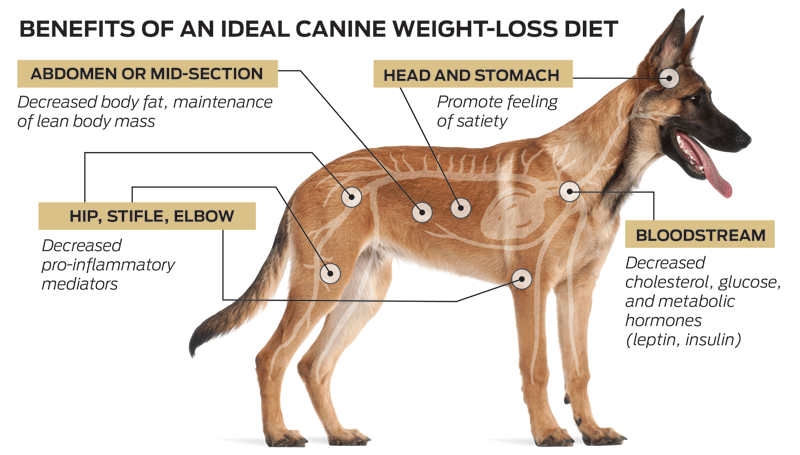By Yuanlong Pan, BVM, PhD, Fellow Scientist, Nestlé Purina
 While all weight-management diets are designed to reduce a dog’s daily intake of calories, there is more to successful weight loss than calorie reduction. The nutritional composition of the ideal diet should also address the following objectives:
While all weight-management diets are designed to reduce a dog’s daily intake of calories, there is more to successful weight loss than calorie reduction. The nutritional composition of the ideal diet should also address the following objectives:
-
- Facilitate fat loss while minimizing loss of lean body mass. A high-protein diet is key to a dog losing fat without also losing muscle. If a dog loses significant amounts of muscle when losing weight, the effort will be counterproductive, because lean body mass is more metabolically active and expends more energy than fat tissue.
- Promote satiety. A combination of high protein and fiber can lead to better satiety-promoting results than either component alone.1 Because the amino acids from protein digestion are absorbed slowly, little insulin is induced and hypoglycemia—which contributes to feelings of hunger—is delayed. Increased dietary fiber also promotes satiety by reducing the caloric density of the food (thus allowing the dog to eat more food without consuming more calories) and triggering a “full” feeling.
- Reduce inflammation. Obesity is associated with low-grade, chronic inflammation, which can lead to common canine diseases like osteoarthritis, as well as other inflammatory diseases such as diabetes and cancer. A weight-management diet rich in omega-3 fatty acids may help reduce inflammation.
- Manage key parameters of metabolic health. Along with reducing glucose and insulin, an ideal weight-management diet should reduce levels of leptin, cholesterol. and triglycerides.
- Address weight rebound. Unfortunately, rebound is common after weight loss, which means that weight easily increases when pre-weight-loss habits are resumed. In dogs, adding soy germ meal containing compounds known as isoflavones to the diet can increase energy metabolism and help reduce the risk of weight rebound.2
I recently conducted a study for a new metabolic weight-management diet. The six-month study included two groups of overweight dogs with an average body condition score (BCS) of 7.8—a control group and a group that consumed the metabolic test diet. The test diet had a 3:1 protein/starch ratio, while both diets had similar energy densities as measured in kcal/kg ME. Caloric restriction was 25% MER for months 1-4 and 40% MER for months 5-6.
Although there was no significant difference in the amount of weight lost between the two groups at the conclusion of the trial, there were significant differences in body composition and other metabolic parameters that are vital to healthy weight loss. For example, dogs on the metabolic test diet lost significantly more body fat than the control dogs but did not lose significant lean body mass; dogs in the control group, however, lost significant amounts of lean body mass compared with baseline.
- Postprandial glucose was significantly lower in the dogs fed the test diet versus control at the study’s end.
- After six months of weight loss, the average change in fasting serum insulin from baseline was 4 times lower in the dogs fed the test diet compared to the change in insulin from baseline in dogs fed the control diet.
- Serum cholesterol decreased 45% and triglycerides 35% in the dogs fed the test diet over the six-month study.
- Dogs eating the metabolic test diet had reduced select pro-inflammatory cytokines after six months of weight loss.
References
- Weber M, Bissot T, Servet E, et al. A High-Protein, High-Fiber Diet Designed for Weight Loss Improves Satiety in Dogs. J Vet Intern Med 2007;21:1203–1208.
- Pan Y. Soy germ isoflavones supplementation reduced body fat accumulation and enhanced energy metabolism in dogs. J Vet Inter Med 2012;26:812–813.
